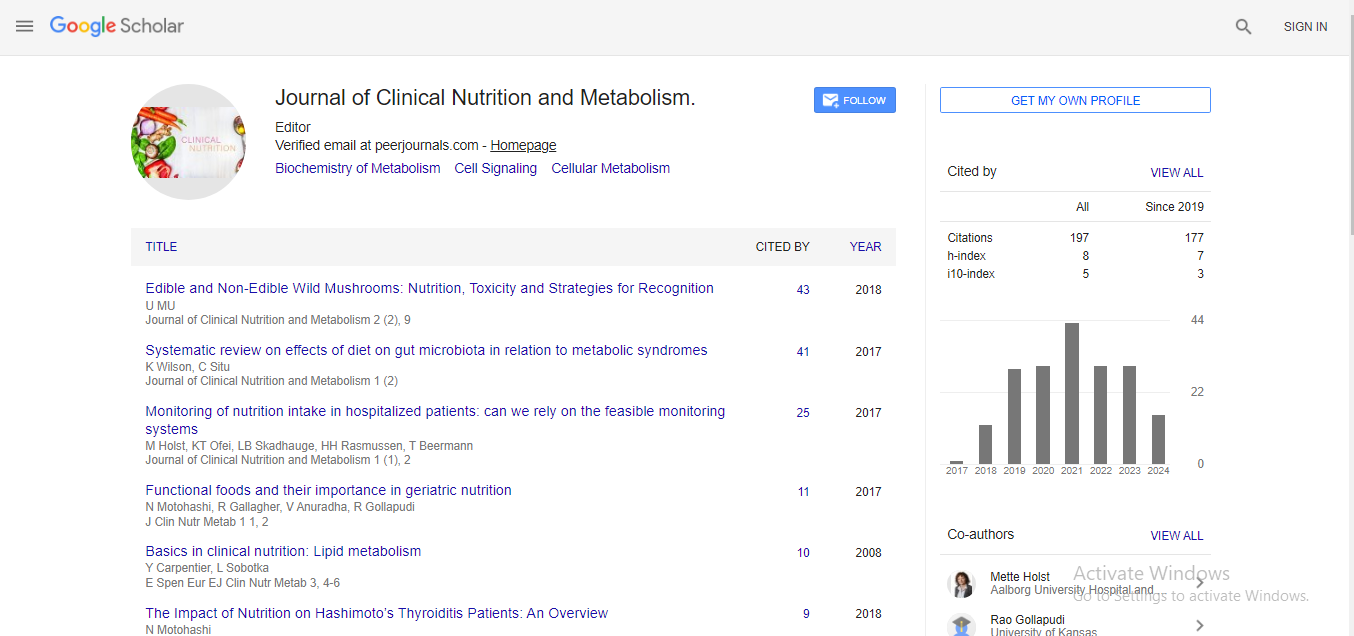Short Communication, J Clin Nutr Metab Vol: 5 Issue: 1
The effect of low dietary carbohydrate advice on glycemic control in patients with type 2 diabetes - Fatima Alzain Adam Adeela - Ministry of Health
Fatima Alzain Adam Adeela Ministry of Health, Sudan
Keywords: dietary carbohydrate , type 2 diabetes
Foundation: Type 2 diabetes is one of the most testing clinical issues on account of the requests it forces on everyday life. Great glycemic control (GC), as decided by GbA1c, fasting serum plasma glucose (SPG) and irregular (SPG) levels. Diet assumes a significant job in the general administration of type 2 diabetes. Reason: The design is to survey the impact of Dietary Advice (DA) on glycemic control in patients with type 2 diabetes and to decide long haul and momentary entanglement of diabetes by low dietary sugar exhortation on metabolic control and personal satisfaction in tolerant with type 2 diabetes. Exploration Design and Methods: Randomized patients going to a diabetes instruction facility at essential social insurance communities were incorporated. The examination focused on an all-out number of 99 cases (35 male – 76 female) of type 2 diabetes matured between 20–80 years. Contingent upon the treatment of oral hypoglycemic specialists subjects estimated (SPG) for fasting and (SPG) for arbitrary, weight and stature for weight list (BMI) when mediation. Objective: In China, a low-fat eating routine (LFD) is for the most part prescribed to help improve blood glucose levels in patients with type 2 diabetes mellitus (T2DM). Nonetheless, a low-sugar diet (LCD) has been demonstrated to be compelling in improving blood glucose levels in America and England. A couple of studies, basically randomized controlled preliminaries, have been accounted for in China too. Strategy: Firstly, we structured two 'sixpoint equation' strategies, which met the necessities of LCD and LFD, separately. Fifty-six T2DM patients were enlisted and arbitrarily apportioned to the LCD gathering (n = 28) and the LFD gathering (n = 28). The LCD bunch got instruction about LCD's six-point recipe, while the LFD bunch got training about LFD's six-point equation. The subsequent time was three months. The pointers for glycemic control and other metabolic boundaries were gathered and looked at between the two gatherings. Results: Fortynine patients finished the examination. The extents of Calories from three macronutrients the patients devoured met the necessities of LCD and LFD. Contrasted with the LFD gathering, there was a more noteworthy diminishing in HbA1c level in the LCD gathering (−0.63% versus −0.31%, p < 0.05). The doses of insulin and fasting blood glucoses (FBG) in the third month were lower than those at pattern in the two gatherings. Contrasted and gauge esteems, weight record (BMI) and absolute cholesterol (TC) in the LCD bunch were essentially decreased in the third month (p < 0.05); be that as it may, there were no factually noteworthy contrasts in the LFD gathering. Ends: LCD can improve blood glucose more than LFD in Chinese patients with T2DM. It can likewise manage blood lipid, diminish BMI, and abatement insulin portion in patients with T2DM. Also, the six-point recipe is possible, effectively operable, and a handy instructive eating routine for Chinese patients with T2DM. Dietary mediation is a methodology to oversee diabetes mellitus (DM), as it can decrease the weight on islet cells and along these lines improve blood glucose levels, lipid profiles, and psychological status. Be that as it may, great adherence to diabetic eating regimens is the reason of diet treatment. In China, a low-fat eating regimen (LFD) is principally prescribed to help improve blood glucose levels in patients with type 2 diabetes mellitus (T2DM). Studies have indicated that LFD could diminish glycated hemoglobin (HbA1c) by as much as 0.8– 2.8%. Then again, a low-sugar diet (LCD) is a dietary system that alludes to starch admission of between 30–200 g/day or calories from carbs/all out calories of <45%, enhancing rather with fat or protein. This has been seen as viable in the treatment of heftiness, and separated from fundamentally diminishing weight, it can likewise successfully improve blood lipid and insulin opposition. As of late, the American Diabetes Association and Diabetes UK have both affirmed the adequacy of LCD in decreasing weight, improving blood glucose, and controlling blood lipid in patients with DM. In Japan, Yamada revealed that HbA1c and triglyceride (TG) levels in patients with T2DM diminished essentially in the LCD bunch without calorie-limitation, contrasted with the LFD bunch with calorie-limitation. This demonstrates LCD made patients with DM want to eat because of a sentiment of satiety. In any case, just constrained examinations identifying with the utilization of LCD in patients with DM, particularly randomized controlled preliminaries, have been accounted for in China. Results: Medical result quantifies the difference in glycemic control among the objective gathering when the nourishment training. Results: After the mediation time of a year, subjects have demonstrated huge lower circling levels of (SPG) for fasting which is 49%, levels of (SPG) for irregular which is 51.5% and a diminished body weight. Ends: DI decidedly tweaks the GC without expanding the danger of hypoglycemia and improves the personal satisfaction in quiet with type 2 diabetes.
 Spanish
Spanish  Chinese
Chinese  Russian
Russian  German
German  French
French  Japanese
Japanese  Portuguese
Portuguese  Hindi
Hindi 